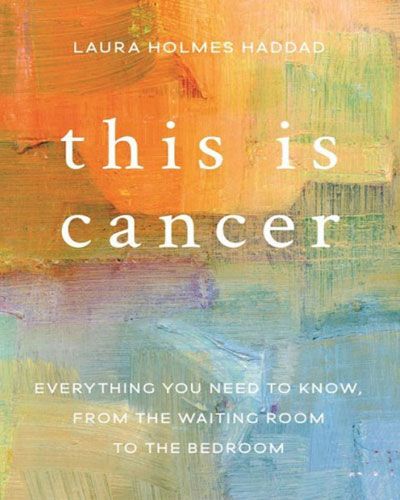This is Cancer by Laura Holmes Haddad

Summary
In her first book, This is Cancer: Everything You Need to Know, from the Waiting Room to the Bedroom, Laura Holmes Haddad takes us on her personal encounter with breast cancer, which she describes as a road trip. After reading the book I felt as if I’d been on that trip with her.
The mother of two small children, at 37 the author was diagnosed with stage IV inflammatory breast cancer. She knew little about cancer, not the different types of breast cancer or what staging means. She started her road trip from mile zero. She shares much of what she learned along the way in “This is Cancer,” providing practical guidance for others.
What’s in the book
Laura divided the book into three main sections: diagnosis, treatment, and survival, followed by an epilogue, some specific tools and an extensive listing of resources.
Diagnosis
She talks about the bewilderment that accompanied her diagnosis. She describes her fear of the medical world, of how she hated getting her teeth cleaned, and of how her fears caused her to put off seeking medical help.
The author covers a lot of bases in this section, providing guidance on topics as far ranging as which friends to surround yourself with, how to get a second opinion, and an overview of the scans and tests that are routinely needed. She talks about fear – things to fear and things not to fear - and its flip-side, hope. She talks about how to care for your caretaker, and the importance of doing so. She offers tips on tackling the paperwork and costs that accompany a cancer diagnosis, and gives a glimpse into the world of foundations that can assist with finances or transportation. Part 1 also includes a dictionary of terms (“cancerspeak” as the author calls it), which will be useful to patient, friends, and family alike.
Treatment
Laura gives an overview of the various types of treatment–chemo, radiation, and surgery–and gives a detailed account of what to expect, how to prepare, and possible side effects. As someone who had several hospital stays, she identifies things you can do to make a long hospital stay more comfortable. Laura also provides an overview of clinical trials and, as a clinical trial participant herself, she talks about what you can expect.
Part 2 also discusses food, and the difficulties of eating when going through chemo. This is the one part of the book that gave me pause. While Laura points out that most medical facilities have a dietitian or nutritionist on staff, it doesn’t appear from what she writes that this was an area where she was helped. She states that her experience during chemo was that she could tolerate “noodles, beef, pizza, toast, and yogurt…” It seems that she missed out on the ways that food and nutrition may help reduce side effects of treatment.
One statement in this section that especially resonated with me is “there is no prize for the best patient.” It’s so true. As Laura says, “Whatever you need to make your day, your week, your month more tolerable, you should ask for it.” Nobody wins by your suffering in silence.
Importantly for patients who are parents and partners, Part 2 also addresses how to talk to your children (as well as partners and family members) about your diagnosis, and the importance of maintaining a routine for your children.
Survival
Discusses the unexpectedly nuanced issues that face cancer survivors, from struggling to understand and achieve “new normal” to worrying that every sore throat indicates a recurrence. She provides practical advice on how to create a follow-up plan and what questions to ask.
The Epilogue brings us up to date on the author, which, happily, as of June 2016, is that she is doing well and enjoying her life.
A Notes section provides a sample medication chart (to keep track of your own), a sample cheat sheet (to record drug allergies, blood type, hospitalizations, etc. and aid in filling in all those medical forms), and a list of sample questions to ask the oncologist. The book wraps up with a diverse listing of resources, including cancer-specific service organizations, sources for financial and legal assistance, retreats for people receiving cancer treatment and breast cancer organizations (including Zero Breast Cancer!)
Conclusion
As the author says, there’s no need to read this book from cover to cover, or even to finish it; you can dip into as you need, reading whichever chapter/s seem appropriate. (It has a good index, which helps when trying to re-find information.) The book is a nice small format, so fits easily into most bags and be handy whenever you have a few minutes to spare. Although the advice is based on one person’s experience with breast cancer, much of it will apply to those facing different types of cancer.
Laura Holmes Haddad approaches this difficult subject with honesty, humor and intelligence. Her writing style is engaging and easy to read. Indeed, as I read it, I found myself feeling variously anxious, exhausted or elated, and was unwilling to put the book down until I’d finished.
This book is 366 pages.
To learn more about Laura Holmes Haddad, visit her site here!
Review by Kathie Farrell from CALMERme.com

